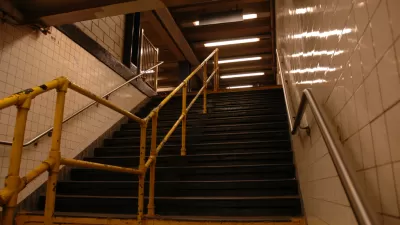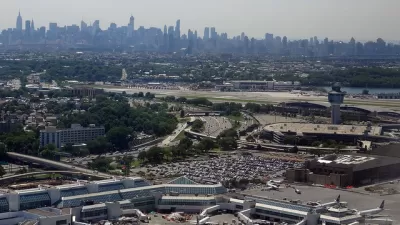The $2.50 subway fare is set to rise by a quarter, but will service improve? This New York Times article focuses on problems plaguing the 110-year-old New York subway (second oldest after Boston's), but fares are increasing for all MTA services.
According to the Metropolitan Transportation Authority (MTA) webpage, "Fares and tolls will go up by 4% over the next two years with the increases set to take effect March 22 on MTA New York City Transit buses and subways, MTA Bus, the MTA Staten Island Railway, and MTA Bridges and Tunnels (and) MTA Long Island Rail Road and MTA Metro-North Railroad.
“We are seeing a system that is bursting at the seams in terms of increased ridership,” Kevin Ortiz, a spokesman for the transportation agency, said.
The plan proposes $32 billion in spending over five years, but it is $15 billion short — the largest funding gap ever and a striking sign of the difference between what the system needs and what the authority can afford," writes Fitzsimmons.
As note here earlier, "(f)are increases are now scheduled to be raised every two years." "The previous increase, in 2013, raised the base fare to $2.50, from $2.25," wrote Fitzsimmons in January.
MTA is a state, not a city or regional agency. Gov. Andrew Cuomo "called the plan 'bloated' and has not addressed the funding gap, instead publicly drawing attention to other infrastructure projects, including a new Tappan Zee Bridge and his proposal for an AirTrain to La Guardia Airport."
Do you have a gripe about NYC subway service? Riders Alliance wants to know. Post your subway horror story on their webpage.
FULL STORY: Crowds and Long Delays Fray Subway System and Riders’ Nerves

Study: Maui’s Plan to Convert Vacation Rentals to Long-Term Housing Could Cause Nearly $1 Billion Economic Loss
The plan would reduce visitor accommodation by 25,% resulting in 1,900 jobs lost.

North Texas Transit Leaders Tout Benefits of TOD for Growing Region
At a summit focused on transit-oriented development, policymakers discussed how North Texas’ expanded light rail system can serve as a tool for economic growth.

Using Old Oil and Gas Wells for Green Energy Storage
Penn State researchers have found that repurposing abandoned oil and gas wells for geothermal-assisted compressed-air energy storage can boost efficiency, reduce environmental risks, and support clean energy and job transitions.

Private Donations Propel Early Restoration of Palisades Playground
Los Angeles has secured over $1.3 million in private funding to restore the Pacific Palisades playground months ahead of schedule, creating a modern, accessible space that supports community healing after recent wildfires.

From Blight to Benefit: Early Results From California’s Equitable Cleanup Program
The Equitable Community Revitalization Grant (ECRG) program is reshaping brownfield redevelopment by prioritizing projects in low-income and environmental justice communities, emphasizing equity, transparency, and community benefits.

Planting Relief: Tackling Las Vegas Heat One Tree at a Time
Nevada Plants, a Las Vegas-based nonprofit, is combating the city’s extreme urban heat by giving away trees to residents in underserved neighborhoods, promoting shade, sustainability, and community health.
Urban Design for Planners 1: Software Tools
This six-course series explores essential urban design concepts using open source software and equips planners with the tools they need to participate fully in the urban design process.
Planning for Universal Design
Learn the tools for implementing Universal Design in planning regulations.
Ascent Environmental
Borough of Carlisle
Institute for Housing and Urban Development Studies (IHS)
City of Grandview
Harvard GSD Executive Education
Toledo-Lucas County Plan Commissions
Salt Lake City
NYU Wagner Graduate School of Public Service





























